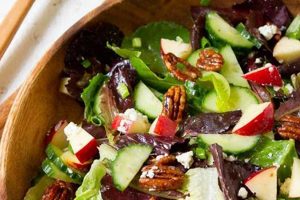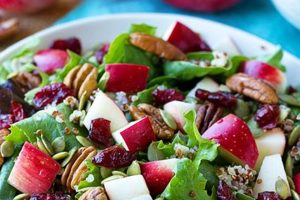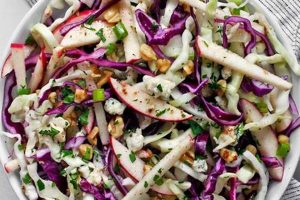A combination of leafy greens, crisp fruit, and often additional ingredients like nuts, dried fruit, cheese, or a flavorful dressing creates a nutritious and refreshing dish. A typical example incorporates chopped kale, sliced apples, and a vinaigrette, perhaps with additions such as pecans, cranberries, and crumbled goat cheese.
This type of salad offers a balance of flavors and textures, combining the slight bitterness of kale with the sweetness of apples. It provides vitamins, minerals, and fiber, contributing to a healthy diet. The versatility of this dish allows for seasonal variations and adaptations to individual preferences. While the specific origins are difficult to pinpoint, the increasing popularity of salads incorporating both fruits and vegetables reflects a growing awareness of nutritional benefits and culinary creativity.
The following sections will explore specific ingredient choices, dressing options, preparation techniques, and variations to create a delicious and healthful salad.
Tips for a Perfect Kale Apple Salad
Achieving optimal flavor and texture requires attention to detail throughout the preparation process. The following tips offer guidance for creating a truly exceptional salad.
Tip 1: Massage the Kale: Massaging kale leaves with a small amount of olive oil or lemon juice tenderizes them, reducing bitterness and improving texture.
Tip 2: Choose the Right Apple: Honeycrisp, Fuji, or Pink Lady apples offer sweetness and crispness that complements kale. Tart varieties like Granny Smith provide a contrasting flavor profile.
Tip 3: Balance Flavors with the Dressing: A vinaigrette with a balance of acidity and sweetness enhances the salad. Consider incorporating apple cider vinegar, maple syrup, or Dijon mustard.
Tip 4: Add Textural Variety: Toasted nuts, seeds, or dried cranberries provide satisfying crunch. Crumbled cheese or roasted chickpeas contribute protein and additional texture.
Tip 5: Don’t Overdress: Add dressing just before serving to prevent the salad from becoming soggy. Start with a small amount and add more as needed.
Tip 6: Prepare Ingredients in Advance: Washing, chopping, and storing components separately allows for quick assembly when ready to serve.
Tip 7: Consider Seasonal Variations: Explore seasonal additions such as roasted butternut squash in the fall or fresh berries in the summer.
By following these suggestions, one can elevate a simple combination of ingredients into a flavorful and satisfying culinary experience.
These tips provide a foundation for creating a delicious and nutritious salad. Experimentation with different ingredients and techniques will further enhance the culinary experience.
1. Fresh, Vibrant Kale
The foundation of a successful kale apple salad lies in the quality of the kale itself. Fresh, vibrant kale contributes not only nutritional value but also desirable texture and flavor, impacting the overall culinary experience. Selecting and preparing kale correctly is crucial for maximizing its potential in this dish.
- Visual Indicators of Freshness
Deep green color, firm leaves without wilting or yellowing, and an absence of blemishes signify fresh kale. These visual cues indicate optimal quality and contribute to both the aesthetic appeal and the overall flavor of the salad. Choosing vibrant kale ensures a visually appealing and flavorful end product. For example, compare a deep green, crisp leaf of Lacinato kale to a yellowed, wilting leaf; the former promises a more satisfying culinary experience.
- Impact on Texture
Fresh kale offers a robust texture that holds up well when combined with other ingredients. This firmness prevents the salad from becoming soggy and ensures a pleasant mouthfeel. Older, less vibrant kale tends to be tougher and less enjoyable. The difference in texture between fresh and wilted kale can significantly affect the final product’s palatability.
- Flavor Profile Enhancement
Fresh kale possesses a slightly bitter, earthy flavor that balances the sweetness of the apples and the acidity of the dressing. Wilted kale can develop off-flavors, detracting from the overall balance. The subtle bitterness of fresh kale is integral to the salad’s flavor profile, acting as a counterpoint to other ingredients.
- Preparation Techniques for Optimal Quality
Proper handling, such as thorough washing and careful drying, preserves kale’s freshness and prevents premature wilting. Techniques like massaging the leaves with olive oil tenderize the kale, further enhancing texture and reducing bitterness. These steps maximize the kales contribution to the salad.
By prioritizing the selection and preparation of fresh, vibrant kale, the overall quality and enjoyment of a kale apple salad are significantly enhanced. This attention to detail elevates the dish from a simple combination of ingredients to a more complex and satisfying culinary creation.
2. Crisp, Sweet Apples
The success of a kale apple salad hinges significantly on the selection of apples. Crisp, sweet varieties contribute not only textural contrast but also a crucial balancing flavor element. This interplay of texture and taste elevates the salad beyond a simple combination of ingredients, transforming it into a more nuanced culinary experience. The choice of apple variety directly impacts the overall quality and enjoyment of the dish. For instance, a Honeycrisp or Fuji apple provides sweetness and a satisfying crunch, complementing the earthy kale and the acidity of a typical vinaigrette. Conversely, using a mealy or overly tart apple could detract from the desired balance.
The crispness of the apple provides a textural counterpoint to the kale’s somewhat coarse leaves. This contrast creates a more dynamic and enjoyable mouthfeel. Furthermore, the sweetness of the apple tempers the slight bitterness of the kale, creating a harmonious flavor profile. This balance is essential for a well-rounded salad. Consider the difference between a crisp Honeycrisp apple and a softer Red Delicious; the former offers a more substantial bite and a brighter sweetness that enhances the overall salad experience. The practical significance lies in understanding these nuances when selecting apples for this specific application. Choosing the correct variety ensures a successful outcome, maximizing flavor and textural appeal.
Understanding the role of crisp, sweet apples in a kale apple salad allows for informed ingredient selection. This knowledge empowers one to create a balanced and flavorful dish. The interplay of textures and tastes contributes significantly to the overall culinary experience, demonstrating that seemingly simple choices can have a profound impact on the final product. The careful selection of apples is a key factor in elevating this salad from a basic combination of greens and fruit to a more refined and satisfying dish.
3. Complementary Dressing
A complementary dressing is essential for a successful kale apple salad recipe. It unites the individual components, balancing the kale’s subtle bitterness and the apple’s sweetness while adding further depth of flavor and enhancing the overall culinary experience. The dressing should not mask the primary ingredients but rather complement and elevate them.
- Acidity as a Balancing Element
The acidity in a dressing, often derived from vinegar or citrus juice, cuts through the richness of the kale and enhances the apple’s sweetness. A vinaigrette with apple cider vinegar or lemon juice, for example, provides a refreshing counterpoint to the other flavors. This balance prevents the salad from being overly sweet or heavy. The level of acidity should be carefully considered; too much can overpower the delicate flavors, while too little can leave the salad tasting bland.
- Sweetness as a Bridge Between Flavors
Incorporating a touch of sweetness into the dressing, through ingredients like maple syrup or honey, creates a bridge between the kale’s earthiness and the apple’s fruitiness. This subtle sweetness harmonizes the flavors and enhances the overall palatability. The type and amount of sweetener should be carefully chosen to complement the apple variety and other ingredients. For example, a robust honey might pair well with a tart Granny Smith apple, while a lighter maple syrup might suit a sweeter Honeycrisp apple.
- Oil as a Texture and Flavor Enhancer
Oil, such as extra virgin olive oil, not only contributes to the dressing’s texture but also carries flavor compounds and helps distribute them throughout the salad. The choice of oil can further enhance the flavor profile. For example, a walnut oil might complement the nutty notes in the salad, while a lighter olive oil allows the other flavors to shine through. The oil also helps coat the kale leaves, tenderizing them and making them more palatable.
- Seasonings and Spices for Depth and Complexity
Incorporating seasonings and spices, such as Dijon mustard, black pepper, or a pinch of salt, adds depth and complexity to the dressing. These additions can further enhance the interplay of flavors and create a more nuanced culinary experience. For example, a touch of Dijon mustard adds a subtle tang, while freshly ground black pepper provides a hint of spice. These additions should be used judiciously to avoid overpowering the other flavors.
The interplay of these elements in a complementary dressing elevates the kale apple salad. The careful balance of acidity, sweetness, oil, and seasonings enhances the flavors and textures of the core ingredients, resulting in a more harmonious and satisfying culinary experience. The dressing transforms a simple combination of kale and apple into a complex and flavorful dish.
4. Textural Additions
Textural additions play a crucial role in elevating a kale apple salad from simple to exceptional. They introduce contrasting elements that engage the palate and create a more dynamic sensory experience. Beyond mere flavor, the interplay of textures contributes significantly to the overall enjoyment of the dish. A thoughtfully composed kale apple salad strategically incorporates textural variety to enhance its appeal.
- Nuts and Seeds
Nuts and seeds, such as toasted pecans, walnuts, pumpkin seeds, or sunflower seeds, provide a satisfying crunch and nutty flavor. Their contrasting texture against the leafy kale and crisp apple slices creates a more engaging mouthfeel. The choice of nuts or seeds can also influence the flavor profile of the salad; for example, toasted pecans offer a buttery richness, while pumpkin seeds provide a subtle earthiness.
- Dried Fruit
Dried cranberries, raisins, or chopped dates introduce chewiness and concentrated sweetness. These additions offer a textural counterpoint to the other ingredients and complement the sweetness of the apples. The choice of dried fruit should consider the overall flavor balance. For example, tart cranberries offer a contrasting flavor, while sweet dates enhance the existing sweetness.
- Crumbled Cheese
Crumbled cheeses, such as feta, goat cheese, or blue cheese, provide creamy or crumbly textures and a salty, tangy element. This contrasts with the other ingredients and adds depth of flavor. The intensity of the cheese should be considered; a strong blue cheese provides a pungent contrast, while a milder feta offers a subtle saltiness.
- Other Textural Elements
Roasted chickpeas or croutons offer further textural variation and contribute protein or a satisfying crunch. These additions further diversify the sensory experience and add complexity to the overall composition of the salad. Consider roasted chickpeas for a savory element and croutons for a classic crunch.
The strategic incorporation of textural additions transforms a kale apple salad. The interplay of contrasting textures elevates the dish, creating a more engaging and satisfying culinary experience. The careful consideration of these elements demonstrates an understanding of the importance of textural variety in achieving a well-balanced and enjoyable salad.
5. Balanced Flavors
A successful kale apple salad hinges on a careful balance of flavors. The inherent characteristics of kale and appleskale’s slight bitterness and earthiness, and the apple’s sweetness and tartnessnecessitate thoughtful consideration of additional ingredients and a complementary dressing to achieve a harmonious and palatable result. This balance elevates the salad from a simple combination of ingredients to a more nuanced and satisfying dish.
- Bitterness and Sweetness
The inherent slight bitterness of kale necessitates a balancing sweetness, typically provided by the apples. The specific apple variety influences the degree of sweetness; a Honeycrisp apple offers a robust sweetness, while a Granny Smith provides a tart counterpoint. Additional sweetness can be introduced through dried fruit or a touch of honey or maple syrup in the dressing. This interplay creates a foundational flavor balance.
- Acidity as a Counterpoint
Acidity, often introduced through a vinaigrette, plays a crucial role in cutting through the richness of the kale and enhancing the other flavors. Lemon juice, apple cider vinegar, or a combination thereof provides the necessary acidity. This tartness prevents the salad from being overly sweet or heavy, contributing to a more refreshing and balanced flavor profile.
- Earthy and Bright Notes
Kale’s earthy notes benefit from brighter, contrasting flavors. The apple’s sweetness contributes to this, but further brightness can be achieved through citrus zest or the addition of fresh herbs like parsley or mint. These additions create a more complex and well-rounded flavor profile.
- Umami and Salt for Depth
Umami, a savory, satisfying taste, can be introduced through ingredients like toasted nuts, crumbled cheese, or nutritional yeast. A touch of salt enhances and balances the other flavors, creating a more complete and satisfying experience. The level of salt should be carefully considered to avoid overpowering the delicate flavors.
The interplay of these flavor components defines a well-balanced kale apple salad. Careful consideration of each elementbitterness, sweetness, acidity, earthiness, brightness, umami, and saltensures a harmonious and palatable result. This balanced approach elevates the salad, demonstrating that a thoughtful combination of ingredients can create a more complex and satisfying culinary experience.
Frequently Asked Questions
This section addresses common inquiries regarding the preparation and enjoyment of kale apple salads. Clarity on these points facilitates successful culinary outcomes.
Question 1: How can one mitigate kale’s sometimes tough or bitter flavor?
Massaging kale leaves with a small amount of olive oil or lemon juice tenderizes the leaves and reduces bitterness. This process breaks down the tough fibers, making the kale more palatable. Additionally, selecting younger, smaller kale leaves can also minimize bitterness.
Question 2: Which apple varieties are most suitable for this type of salad?
Crisp, sweet apples like Honeycrisp, Fuji, or Pink Lady offer a pleasant contrast to kale’s earthiness. Tart varieties such as Granny Smith can also provide a balancing flavor element. The choice depends on individual preference and the desired flavor profile.
Question 3: What type of dressing best complements the combination of kale and apple?
A vinaigrette with a balance of acidity and sweetness typically complements this salad. Apple cider vinegar or lemon juice provides acidity, while maple syrup or honey adds sweetness. Other additions, such as Dijon mustard or shallots, can further enhance the flavor profile.
Question 4: How can one prevent the salad from becoming soggy?
Adding the dressing just before serving prevents the salad from becoming soggy. Storing the kale and apple separately and combining them only when ready to serve also helps maintain optimal texture.
Question 5: What are some suitable additions to enhance flavor and texture?
Toasted nuts, seeds, dried cranberries, crumbled cheese, and roasted chickpeas are common additions. These ingredients introduce textural variety and complementary flavors, enhancing the overall culinary experience.
Question 6: Can this salad be prepared in advance?
Components can be prepared in advance and stored separately. Washing, chopping, and storing the kale, apples, and other ingredients individually allows for quick assembly when ready to serve. However, the dressing should be added only just before serving to maintain optimal texture.
Understanding these points facilitates successful preparation and enhances enjoyment of kale apple salads. A thoughtful approach to ingredient selection, preparation techniques, and flavor balancing results in a more satisfying culinary outcome.
The following section will offer specific recipe variations for further exploration.
Kale Apple Salad Recipe
Exploration of the components of a successful kale apple salad recipe reveals the importance of ingredient selection, preparation techniques, and flavor balancing. Fresh, vibrant kale provides a nutritious base; crisp, sweet apples offer textural and flavor contrast; and a complementary dressing unites these elements. Textural additions, such as nuts, seeds, or dried fruit, further enhance the sensory experience. Careful attention to the interplay of bitterness, sweetness, acidity, and umami ensures a harmonious and palatable outcome. The synthesis of these elements elevates the dish beyond a simple combination of ingredients.
The potential for variation within the kale apple salad framework allows for continuous culinary exploration. Adaptability to seasonal ingredients and individual preferences ensures ongoing relevance and enjoyment. Understanding the underlying principles of flavor and texture empowers creation of a consistently satisfying and nutritious culinary experience.






